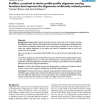122 search results - page 4 / 25 » Improving the quality of protein structure models by selecti... |
ICASSP
2007
IEEE
13 years 11 months ago
2007
IEEE
Protein structure prediction aims to determine the three-dimensional structure of proteins form their amino acid sequences. When a protein does not have similarity (homology) to a...
BMCBI
2007
13 years 5 months ago
2007
Background: The structure annotation of a genome is based either on ab initio methodologies or on similaritiy searches versus molecules that have been already annotated. Ab initio...
BMCBI
2005
13 years 5 months ago
2005
Background: Profile-profile methods have been used for some years now to detect and align homologous proteins. The best such methods use information from the background distributi...
NAR
2002
13 years 5 months ago
2002
PALS db is a collection of Putative Alternative Splicing information from 19 936 human UniGene clusters and 16 615 mouse UniGene clusters. Alternative splicing (AS) sites were pre...
RECOMB
2003
Springer
14 years 5 months ago
2003
Springer
We describe a novel method for detecting the domain structure of a protein from sequence information alone. The method is based on analyzing multiple sequence alignments that are ...

